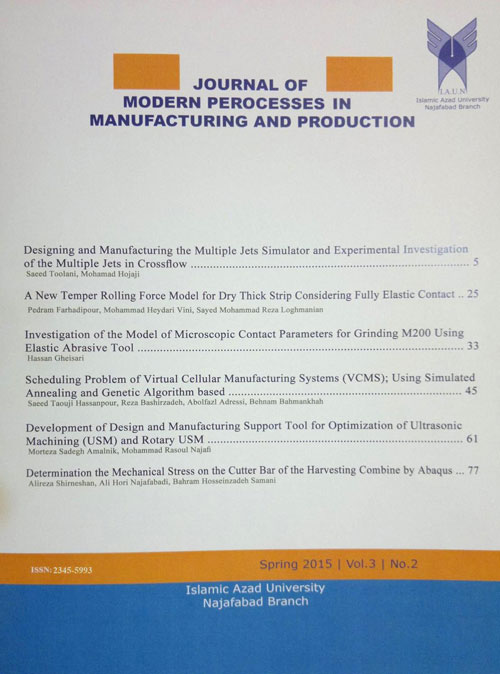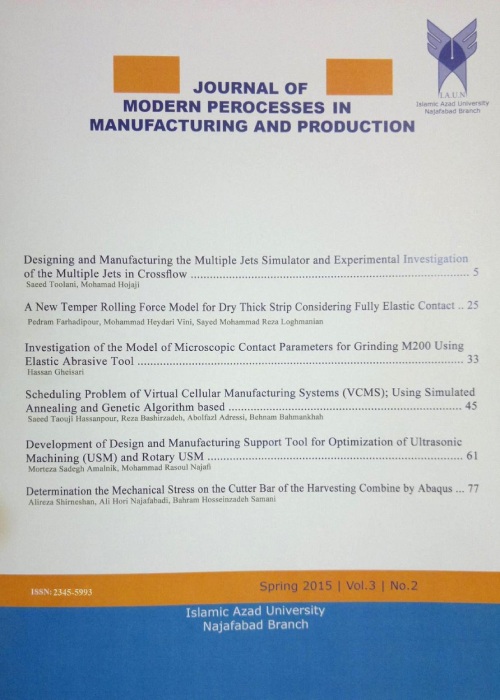فهرست مطالب

Journal of Modern Processes in Manufacturing and Production
Volume:6 Issue: 1, Winter 2017
- تاریخ انتشار: 1396/05/10
- تعداد عناوین: 6
-
Pages 5-13Cold rolling of steel is one of the most important metal forming processes so an accurate control of its parameters during the process is necessary. In this paper, the friction coefficient has been proposed as a function of cold rolling parameters such as forward slip, forward and backward tensile stresses ,strip thickness, static deformation, resistance of strip before and after rolling ,strip velocity before and after rolling and work roll diameters. A cold rolling model for computation of rolling pressure and force with varying friction coefficient and work roll flattening is proposed. The final results obtained from calculations were very close to the experimental results and there has been a good compliance with this method results and other researches and this is the advantage of this model. Finally the rolling forces in two stands with three passes were measured. So, the results demonstrated that an actual process in the two stand reversing cold mill by increasing the work roll flattening the rolling force increased considerably. Also, by increasing the tensile stresses at the end of the steel strip, the rolling force decreased.Keywords: Cold rolling, Steel strip, rolling force, Roll Flattening
-
Pages 15-24Conventional material removal of BK7 optical glass will normally result in brittle fracture at the surface, generating severe subsurface damage and poor surface finish. Subsurface damages induced by grinding strongly influence the mechanical strength and optical quality of optical glasses. However, through ductile mode grinding it is possible to reduce the surface and subsurface cracks. It is meaningful to evaluate the depth of subsurface cracking through the measurement of surface roughness under different grinding parameters. In this research, the surface and subsurface damages during micro cup grinding and lapping process of optical glass BK7 are being investigated. In order to invest the subsurface damages, cross section polishing method is being used and the cross sections are inspected through SEM microscope. The results indicate that number of subsurface median cracks after lapping process are strongly decreased and surface lateral cracks are extended all over the sample's ground surface.Keywords: Optical Glass BK7, Cup Grinding, Subsurface Damages, Ductile Grinding
-
Pages 25-31A hybrid longitudinal-torsional ultrasonic transducer is designed and fabricated in this research. The design of the transducer was performed using the FE method with ABAQUS software, with the aim of combining the longitudinal and torsional vibration modes. The transducer horn is then fabricated using a 4-axis milling machine. The PZT stacks are employed in order to excite the transducer. The transducer body is fabricated with grade 5 titanium for its appropriate mechanical properties. The transducer is then assembled and the experimental tests are carried out to measure the vibration amplitude in both longitudinal and torsional directions using an Eddy current displacement sensor. Theresults showed that the resonance frequencies of both the torsional and longitudinal modes are the same and experimental results are in good agreement with the FE results. The transducer can be used as a vibration tool for vibration assisted drilling which can produce both longitudinal and torsional vibrations.Keywords: Longitudinal-Torsional, transducer, Piezoelectric, ABAQUS, numerical simulation
-
Pages 33-47Electrical Discharge Machining (EDM) process is one of the most widely used methods for machining. This method is used to form parts that conduct electricity. This method of machining has used for hard materials and therefore selects the correct values of parameters which are so effective on the quality machining of parts. Reaching to optimum condition of the DIN1.2080 alloy (D3) machining is very important due to the rapid and widespread use of different industry such as Molding, lathe tools reamer, broaching, cutting guillotine and etc. Therefore the purpose of this study is to consider the effect of the inlet parameters such as current, voltage, pulse on time and pulse off time on the machining chip rate and optimize the inlet parameters for D3 alloy. So to reach better result after doing some experiments to predict and optimize the rate of removing chip, neural network method and genetic algorithm are used. Then optimizing input parameters to maximize the rate of removing chip are performed. In this condition by decreasing time, the product cost is decreased. In this condition, the optimum parameters are obtained under the current of 20 (A), 160 (V), pulse on time of 100 (ms) and pulse off time of12 (ms). At this condition, the rate of machining chip is obtained 0.063 (cm3/min). Also, surveying the level of error and its accuracy are evaluated. According to the obtained error value that is about 5.18%, the used method is evaluated suitable for genetic algorithm.Keywords: EDM, Taguchi method, Optimum determining, optimization, genetic algorithm, ANN
-
Pages 49-67The previous studies about the maintenance systems were dealt with defining the evaluation criteria, grouping them, and using different techniques for evaluating. The main problem is that maintenance subsystems and the relationship between and within them in order to a reliable evaluation have never been identified before.
The contribution of this study is realizing the four maintenance subsystems consisting service and maintenance, inspection, chronic failure, and severe failure and investigating the communication between them that has never been done in previous studies. On the other hand, in each subsystem the relationship between causal conditions, phenomenon, mediator condition, strategies and consequences that had been neglected in previous studies are discussed for the very first time. Causal conditions, that cause each of four subsystems, are identified. Then phenomenon and mediator conditions are presented and the strategy that should be made based on the characteristic of phenomenon and mediator condition is determined as well. Since making a strategy can lead to a consequence, the consequences according to different strategies are identified that has never been done in previous studies. At last, the relations between these parts are presented in narratives.Keywords: Maintenance Evaluation System, Meta, synthesis, Grounded Theory, Maintenance Assessment Criteria -
Pages 69-81Stress concentration factors have been examined in a functionally graded material (FGM) plate with central holes in different shapes in this essay. The material properties change along the thickness of plate. ABAQUS software has been utilized for modeling of problem in which subroutine of ABAQUS sub-program was used for modeling of the targeted material. The considering shapes for hole in plate are circular and elliptical in which stress concentration factors have been studied in different modes in respective of ellipse diameters. Similarly, stress concentration factors have been analyzed in the plate for various coefficients of FGM function. The results show that changes in material properties and the shape of hole in plate affect the stress concentration factor around the hole. An experiment was implemented to determine verification of results from Finite Element Method (EFM).Keywords: Stress Concentration Factor, Functionally Graded Material, finite element, Subroutine


